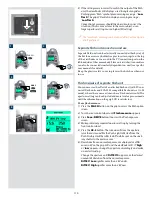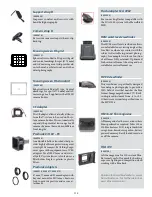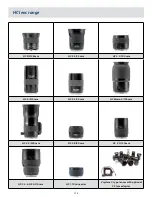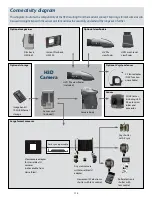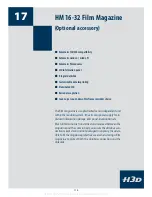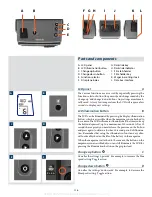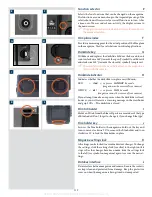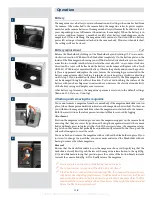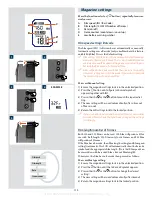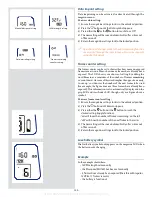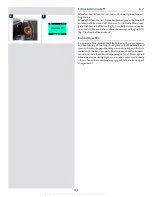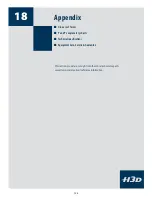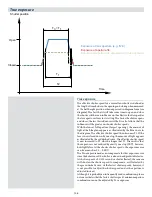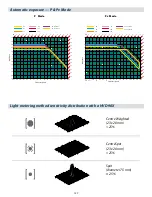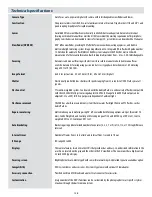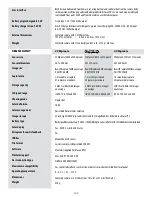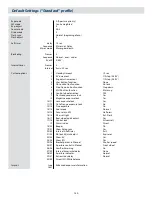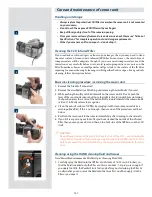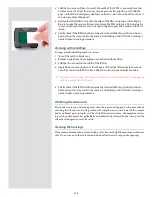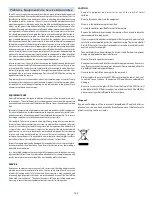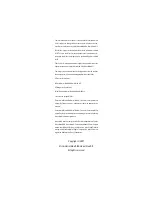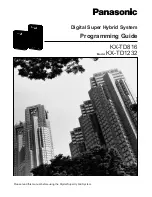
Glossary of Terms
For the sake of clarity, here are short and simple explanations of several
terms, items and features mentioned in the manual that may be unfamil-
iar to some.
Bracketing
The practice of making extra exposures over or under (normally
both) the ‘standard’ exposure to ensure the desired result. This is
particularly useful in difficult, wide-ranging lighting conditions.
Easily set and controlled with the H3D.
Custom setting
The setting chosen by the user that differs from the default set-
ting.
Click / Press – On.Off button
The ON.OFF button can be depressed in two different ways which
in turn cause different results. This distinction is referred to in the
text as
clicking
and
pressing
.
Clicking
is a very rapid depressing
of the button with immediate release whereas
pressing
is a longer
depression of the button with maintained pressure.
EV
Exposure Value. It represents the standard photographic notation
within exposure control. For example, if you change the aperture
on a lens from f/11 to f/8, you will increase the exposure by 1EV.
Similarly, if you change the shutter speed from 1/15s to 1/60s you
will decrease the exposure by 2EV. A change in EV can therefore
represent a change in aperture, shutter speed or a mixture of both.
It is a simpler and more useful way of referring to the essential
effective combination when making exposure settings without
referring to the implications and sometimes confusing aspects of
specific shutter speeds or apertures.
As a practical example, if you are using ‘exposure compensation’,
the settings are in EV’s (often referred to as ‘stops’ in older de-
scriptions) or fractions of EVs (or ‘stops’). Therefore an exposure
compensation of +1EV, for example, will provide ‘one stop over-
exposure’ and similarly an exposure compensation of -1/2EV, for
example, will provide ‘ a half stop underexposure’.
See the chart in this manual for cross reference of EVs and their
aperture/shutter speed equivalents
DAC
The “Digital APO Correction” or DAC feature optimizes lens
performance by automatically including lens specific metadata
with every image. APO-chromatic correction is then implemented
which reduces colour fringing and corrects distortion to provide
the optimum performance of the lens at all settings.
Default setting / factory setting
A standard setting that a device is set to in the first instance dur-
ing manufacture and returns to if a setting change is halted or
interrupted in any way.
FireWire
FireWire is an interface standard that provides the rapid com-
munication of data information between separate units. The H3D
uses Firewire to connect to an Imagebank or computer.
Half-press / Full press – Shutter release button
The shutter release button can be depressed in two different ways.
This distinction is referred to in the text as
half-press
and
full-press
positions. A
half-press
is a rapid, soft press whereas a
full-press
is
a firmer and longer depression of the button.
IAA
Instant Approval Architecture or IAA provides the user with a
method of classifying images either immediately after capture or
at any other time. This greatly improves workflow efficiency.
LCD
Liquid Crystal Display. An electronic information panel. The grip
and magazine both have LCD panels.
LED
Light Emitting Diode. Electronic devices used in information
displays. The viewfinder display has LED’s to the left and right of
the integral LCD panel.
Mid-grey / 18% grey
An important point to be remembered is that all photographic
exposure meters / light metering systems are calibrated to provide
a reading that will reproduce a ‘mid-grey or 18% grey tone’ from
the measured subject tone. This is an international photographic
standard upon which all exposure calculations must be based.
The H3D has very accurate and sophisticated exposure measuring
modes. Pre-programmed information is taken into account via the
metering system when calculations are automatically made. This
provides a very satisfactory compromise for a host of photographic
situations and many users will certainly be very satisfied with
the consistently high quality of results. Nevertheless, some situ-
ations are either so technically difficult or open to interpretation
that manual intervention is advised to ensure the desired result.
Naturally, many seasoned users always prefer manual control but
they base their calculations and decisions on much experience.
To illustrate this point, imagine the following example:
Pin two sheets of paper, one black and the other white, onto a
grey wall. Take three exposures using an average light reading;
a close-up of the black sheet, a close-up of the white sheet, and a
distance shot of the whole wall including the two sheets. Without
any manipulation, the first two exposures will produce a tone that
is similar to the wall, namely, a grey tone; not black or white. The
third exposure, however, will reproduce the wall as a grey tone
while the two respective sheets now appear as black and white
respectively, as originally observed.
However confusing this might at first seem, it is fundamental to
mastering exposure calculations and exposure control. If you are at
all unsure about this basic concept, you are strongly recommended
to refer to a general photographic manual for a fuller explanation
in order to obtain the maximum from your H3D.
OLED
Organic Light-Emitting Diode - a display device that emits light
and thereby does not require backlighting.
124

